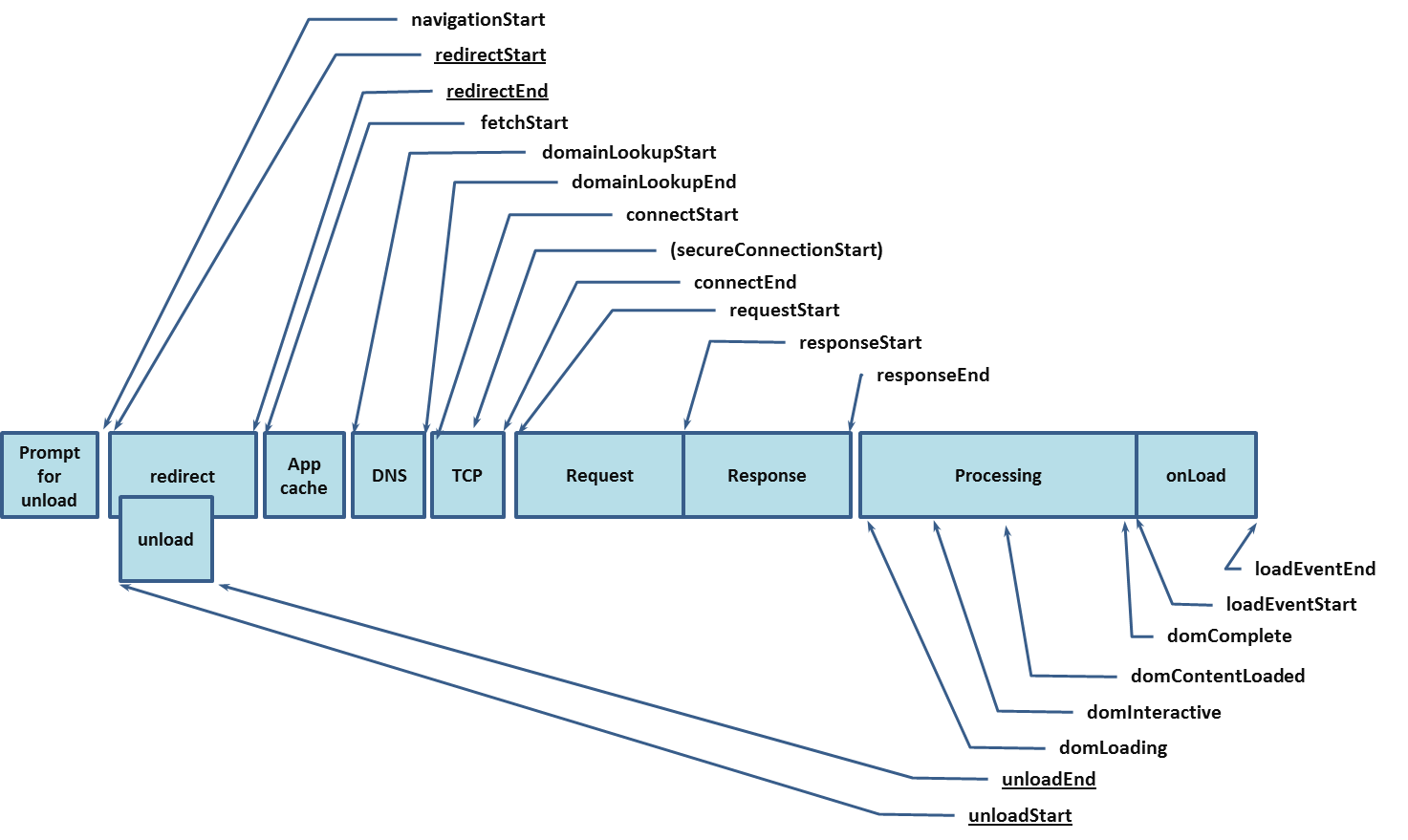# puppeteer实战系列-网页性能分析
前两篇文章中,我们讲了安装和截图,这篇我们来讲讲页面性能分析的相关体系。
众所周知,页面性能优化要讲起来可谓是整大条链路上的事情,在这里我就不开展描述,后续我会出个全面的性能优化系列文章再进行讲解。回到我们的正题,我们是利用puppeteer对页面进行性能数据采集并分析,达到一个性能监控的效果。
这里我是用的 Web performance 收集的,毕竟是原生对吧。 GoogleChrome 推的 lighthouse 也是个不错的工具,感兴趣的同学可自行研究 传送门
当然了,咱们要分析的页面在这里不是咱自家产的,假如是自家页面,那我们只需要将代码包装成sdk,用户访问的时候收集真实数据,再分析即可。所以这里主要是模拟分析第三方的页面。在讲具体操作前,我们先来认识一下 performance,看下图


相关时间点在timing里,加载的资源列表在getEntries里,我也是根据下面这张图来归结相关时间节点数据的,有不对的地方同学们帮忙指正下。

# 核心代码
function performance() {
const data = {
cache: ['domainLookupStart', 'fetchStart'], // 读取缓存时间
dns: ['domainLookupEnd', 'domainLookupStart'], // DNS 解析耗时
tcp: ['connectEnd', 'connectStart'], // TCP 连接耗时
req: ['responseStart', 'requestStart'], // 网络请求耗时
res: ['responseEnd', 'responseStart'], // 数据传输耗时
dom: ['domContentLoadedEventStart', 'domLoading'], // DOM 解析耗时
readycb: ['domContentLoadedEventEnd', 'domContentLoadedEventStart'], // domContentLoaded回调函数耗时
fasrt: ['domComplete', 'domContentLoadedEventEnd'], // 首屏异步资源加载耗时,即domContentLoaded和load之间加载的资源,一般为图片加载,JS异步加载的资源
loadcb: ['loadEventEnd', 'loadEventStart'], // load回调函数耗时
ready: ['domContentLoadedEventEnd', 'fetchStart'], // DOM Ready耗时,白屏时间
load: ['loadEventEnd', 'fetchStart'] // 页面完全加载时间
};
const getData = {};
const performance = window.performance || window.msPerformance || window.webkitPerformance;
if (!performance || !performance.timing) {
return null;
}
const timing = performance.timing;
Object.keys(data).map(item => {
const firstParams = timing[data[item][0]];
const secondParams = timing[data[item][1]];
const value = Math.round(firstParams - secondParams);
value >= 0 && value < 36e5 && (getData[item] = value);
});
getData.resourceList = performance.getEntries();
return getData;
}
所以当我们加载第三方页面的时候,我们插入此脚本,把数据捞出来,下面举个🌰
const browser = await puppeteer.launch({
headless: true,
args: [ '--no-sandbox', '--disable-setuid-sandbox' ],
});
const page = await browser.newPage();
await page.goto('https://juejin.im', {
waitUntil: [ 'load' ]
});
const monitorData = await page.evaluate(() => {
// 这里就拿我们最常见也最关心的数据,更全的看上面核心代码图即可
const data = {
ready: [ 'domContentLoadedEventEnd', 'fetchStart' ], // DOM Ready耗时,白屏时间
load: [ 'loadEventEnd', 'fetchStart' ] // 页面完全加载时间
};
const getData = {};
const performance = window.performance || window.msPerformance || window.webkitPerformance;
const timing = performance.timing;
Object.keys(data).map(item => {
const firstParams = timing[data[item][0]];
const secondParams = timing[data[item][1]];
const value = Math.round(firstParams - secondParams);
value >= 0 && value < 36e5 && (getData[item] = value);
});
getData.resourceList = performance.getEntries();
return Promise.resolve(getData);
});
console.log(monitorData);
拿到这些数据后,就可以开展各自的业务的场景了,比如后台系统上的展示监控,钉钉报警优化等等。 再复杂一点的场景可能需要模拟网络环境,我们需要再添加一些代码,如下:
const NETWORK_PRESETS = {
// 所有速度 / 8 是因为网络速度通常以比特/秒,而 DevTools 预计吞吐量在字节/秒! (1字节 = 8比特)
GPRS: {
offline: false, // 是否连接
downloadThroughput: (50 * 1024) / 8, // 模拟下载速度
uploadThroughput: (20 * 1024) / 8, // 模拟上传速度
latency: 500 // 模拟延迟(毫秒)
},
Regular2G: {
offline: false,
downloadThroughput: (250 * 1024) / 8,
uploadThroughput: (50 * 1024) / 8,
latency: 300
},
Good2G: {
offline: false,
downloadThroughput: (450 * 1024) / 8,
uploadThroughput: (150 * 1024) / 8,
latency: 150
},
Regular3G: {
offline: false,
downloadThroughput: (750 * 1024) / 8,
uploadThroughput: (250 * 1024) / 8,
latency: 100
},
Good3G: {
offline: false,
downloadThroughput: (1.5 * 1024 * 1024) / 8,
uploadThroughput: (750 * 1024) / 8,
latency: 40
},
Regular4G: {
offline: false,
downloadThroughput: (4 * 1024 * 1024) / 8,
uploadThroughput: (3 * 1024 * 1024) / 8,
latency: 20
},
DSL: {
offline: false,
downloadThroughput: (2 * 1024 * 1024) / 8,
uploadThroughput: (1 * 1024 * 1024) / 8,
latency: 5
},
WiFi: {
offline: false,
downloadThroughput: (30 * 1024 * 1024) / 8,
uploadThroughput: (15 * 1024 * 1024) / 8,
latency: 2
}
};
async function start(url, network) {
const browser = await puppeteer.launch({
headless: true,
args: [ '--no-sandbox', '--disable-setuid-sandbox' ],
});
const page = await browser.newPage();
await page.goto(url, { waitUntil: [ 'load' ]});
// 添加网络环境
if (network !== 'default') {
// Connect to Chrome DevTools
const client = await page.target().createCDPSession();
// Set throttling property
await client.send('Network.emulateNetworkConditions', NETWORK_PRESETS[network]);
}
const monitorData = await page.evaluate(() => {
// ...同上
});
console.log(monitorData);
}
# 总结
window.performance.getEntries() 的方式拿到的资源,不是本域下面的话,一般是拿不到资源大小的,这个是由第三方cdn或者服务器所控制的。lighthouse 是拿得到的,所以根据各自场景,结合起来使用也是没问题的。另外 puppeteer 本身也提供一些页面数据在 page.metrics() 方法里,同学们可自行查看。